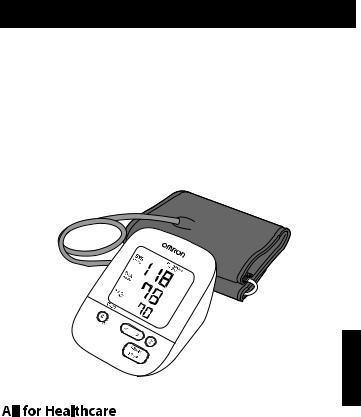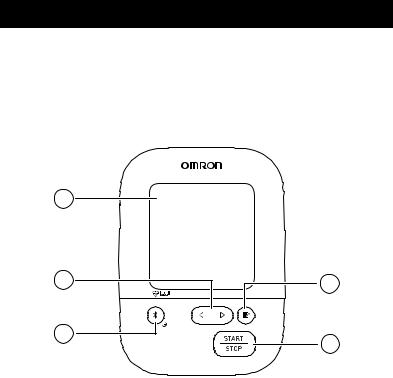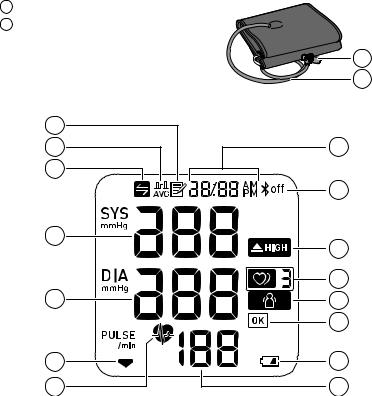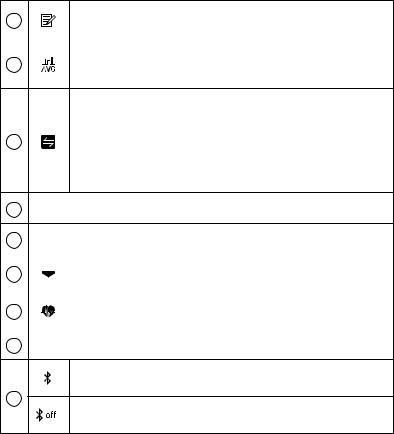Omron BP7250 User manual



 ®
®
INSTRUCTION MANUAL
5 series Upper Arm Blood Pressure Monitor
Model BP7250
<![endif]>ENGLISH

|
Table of Contents |
|
Introduction .................................................................................................. |
3 |
|
Important Safety Information........................................................................ |
5 |
|
1. |
Know Your Monitor .............................................................................. |
11 |
2. |
Preparation .......................................................................................... |
18 |
3. |
Using Your Monitor without a Smart Device ........................................ |
24 |
4. |
Using Your Monitor with a Smart Device ............................................. |
27 |
5. |
Using Memory Function ....................................................................... |
30 |
6. |
Other Settings...................................................................................... |
32 |
7. |
Error Messages and Troubleshooting.................................................. |
34 |
8. |
Maintenance ........................................................................................ |
39 |
9. |
Optional Accessories ........................................................................... |
41 |
10. |
Specifications....................................................................................... |
43 |
11. |
FCC Statement .................................................................................... |
46 |
12. |
Limited Warranty.................................................................................. |
48 |
13. |
Guidance and Manufacturer’s Declaration........................................... |
50 |
2

Introduction
Thank you for purchasing the OMRON BP7250 Blood Pressure Monitor. This monitor can be used by multiple users. This blood pressure monitor uses the oscillometric method of blood pressure measurement. This means this monitor detects your blood movement through your brachial artery and converts the movements into a digital reading.
Safety Instructions
This instruction manual provides you with important information about the OMRON BP7250 Blood Pressure Monitor. To ensure the safe and proper use of this monitor, READ and UNDERSTAND all of the safety and operating instructions. If you do not understand these instructions or have any questions, contact
1-800-634-4350 before attempting to use this monitor. For specific information about your own blood pressure, consult with your physician.
Intended Use
This device is a digital monitor intended for use in measuring blood pressure and pulse rate in adult patient population. The device detects the appearance of irregular heartbeats during measurement and gives a warning signal with readings.
Environments of Use: Home
Patient Population: Adult
Receiving and Inspection
Remove this monitor and other components from the packaging and inspect for damage. If this monitor or any other components is damaged, DO NOT USE and contact
1-800-634-4350.
Symbols Glossary
For symbol information, visit: OmronHealthcare.com/symbols-glossary
3

Contraindications
•This monitor is contraindicated for use in ambulatory environments. •This monitor is contraindicated for use on aircraft.
4

Important Safety Information
Read the Important Safety Information in this instruction manual before using this monitor.
Follow this instruction manual thoroughly for your safety.
Keep for future reference. For specific information about your own blood pressure, CONSULT WITH YOUR PHYSICIAN.
Indicates a potentially hazardous situation which, if not  Warning avoided, could result in death or serious injury.
Warning avoided, could result in death or serious injury.
•DO NOT use this monitor on infants, toddlers, children or persons who cannot express themselves.
•DO NOT adjust medication based on readings from this blood pressure monitor. Take medication as prescribed by your physician. ONLY a physician is qualified to diagnose and treat high blood pressure.
•DO NOT use this monitor on an injured arm or an arm under medical treatment.
•DO NOT apply the arm cuff on your arm while on an intravenous drip or blood transfusion.
•DO NOT use this monitor in areas containing high frequency (HF) surgical equipment, magnetic resonance imaging (MRI) equipment, computerized tomography (CT) scanners. This may result in incorrect operation of the monitor and/or cause an inaccurate reading.
•DO NOT use this monitor in oxygen rich environments or near flammable gas.
•Consult with your physician before using this monitor if you have common arrhythmias such as atrial or ventricular premature beats or atrial fibrillation; arterial sclerosis; poor perfusion; diabetes; pregnancy; pre-eclampsia or renal disease. NOTE that any of these conditions in addition to patient motion, trembling, or shivering may affect the measurement reading.
5

•NEVER diagnose or treat yourself based on your readings. ALWAYS consult with your physician.
•To help avoid strangulation, keep the air tube and AC adapter cable away from infants, toddlers or children.
•This product contains small parts that may cause a choking hazard if swallowed by infants, toddlers or children.
Data Transmission
•This product emits radio frequencies (RF) in the 2.4 GHz band. DO NOT use this product in locations where RF is restricted, such as
on an aircraft or in hospitals. Turn off the Bluetooth® feature in this monitor and remove batteries and/or unplug the AC adapter when in RF restricted areas. For further information on potential restrictions refer to documentation on the Bluetooth usage by the FCC.
AC Adapter (optional accessory) Handling and Usage
•DO NOT use the AC adapter if this monitor or the AC adapter cable is damaged. If this monitor or the cable is damaged, turn off the power and unplug the AC adapter immediately.
•Plug the AC adapter into the appropriate voltage outlet. DO NOT use in a multi-outlet plug.
•NEVER plug in or unplug the AC adapter from the electric outlet with wet hands.
•DO NOT disassemble or attempt to repair the AC adapter.
Battery Handling and Usage
•Keep batteries out of the reach of infants, toddlers or children.
6

Indicates a potentially hazardous situation which, if not Caution avoided, may result in minor or moderate injury to the user or
patient, or cause damage to the equipment or other property.
•Stop using this monitor and consult with your physician if you experience skin irritation or discomfort.
•Consult with your physician before using this monitor on an arm where intravascular access or therapy, or an arterio-venous (A-V) shunt, is present because of temporary interference to blood flow which could result in injury.
•Consult with your physician before using this monitor if you have had a mastectomy.
•Consult with your physician before using this monitor if you have severe blood flow problems or blood disorders as cuff inflation can cause bruising.
•DO NOT take measurements more often than necessary because bruising, due to blood flow interference, may occur.
•ONLY inflate the arm cuff when it is applied on your upper arm. •Remove the arm cuff if it does not start deflating during a measurement.
•DO NOT use this monitor for any purpose other than measuring blood pressure.
•During measurement, make sure that no mobile device or any other electrical device that emits electromagnetic fields is within 12 inches (30 cm) of this monitor. This may result in incorrect operation of the monitor and/or cause an inaccurate reading.
•DO NOT disassemble or attempt to repair this monitor or other components. This may cause an inaccurate reading.
•DO NOT use in a location where there is moisture or a risk of water splashing this monitor. This may damage this monitor.
•DO NOT use this monitor in a moving vehicle such as in a car. •DO NOT drop or subject this monitor to strong shocks or vibrations.
•DO NOT use this monitor in places with high or low humidity or high or low temperatures. Refer to section 10.
7
•During measurement, observe the arm to ensure that the monitor is not causing prolonged impairment to blood circulation.
•DO NOT use this monitor in high-use environments such as medical clinics or physician offices.
•DO NOT use this monitor with other medical electrical (ME) equipment simultaneously. This may result in incorrect operation of the monitor and/or cause an inaccurate reading.
•Avoid bathing, drinking alcohol or caffeine, smoking, exercising and eating for at least 30 minutes before taking a measurement. •Rest for at least 5 minutes before taking a measurement.
•Remove tight-fitting, thick clothing from your arm while taking a measurement.
•Remain still and DO NOT talk while taking a measurement. •ONLY use the arm cuff on persons whose arm circumference is within the specified range of the cuff.
•Ensure that this monitor has acclimated to room temperature before taking a measurement. Taking a measurement after an extreme temperature change could lead to an inaccurate reading. OMRON recommends waiting for approximately 2 hours for the monitor to warm up or cool down when the monitor is used in an environment within the temperature specified as operating conditions after it is stored either at the maximum or at the minimum storage temperature. For additional information of operating and storage/transport temperature, refer to section 10. •DO NOT use this monitor after the durable period has ended. Refer to section 10.
•DO NOT crease the arm cuff or the air tube excessively.
•DO NOT fold or kink the air tube while taking a measurement. This may cause an injury by interrupting blood flow.
•To unplug the air plug, pull on the plastic air plug at the base of the tube, not the tube itself.
•ONLY use the AC adapter, arm cuff, batteries and accessories specified for this monitor. Use of unsupported AC adapters, arm cuffs and batteries may damage and/or may be hazardous to this monitor.
8
•ONLY use the approved arm cuff for this monitor. Use of other arm cuffs may result in incorrect readings.
•Inflating to a higher pressure than necessary may result in bruising of the arm where the cuff is applied. NOTE: refer to “If your systolic pressure is more than 210 mmHg” in section 3 of this instruction manual for additional information.
Data Transmission
•DO NOT replace batteries or unplug the AC adapter while your readings are being transferred to your smart device. This may result in incorrect operation of this monitor and failure to transfer your blood pressure data.
AC Adapter (optional accessory) Handling and Usage •Fully insert the AC adapter into the outlet.
•When unplugging the AC adapter from the outlet, be sure to safely pull from the AC adapter. DO NOT pull from the AC adapter cable. •When handling the AC adapter cable:
DO NOT damage it. DO NOT break it.
DO NOT tamper with it.
DO NOT forcibly bend or pull it. DO NOT twist it.
DO NOT use it if it is gathered in a bundle. DO NOT pinch it.
DO NOT place it under heavy objects. •Wipe any dust off of the AC adapter. •Unplug the AC adapter when not in use.
•Unplug the AC adapter before cleaning this monitor.
9

Battery Handling and Usage
•DO NOT insert batteries with their polarities incorrectly aligned. •ONLY use 4 “AA” alkaline or manganese batteries with this monitor. DO NOT use other types of batteries. DO NOT use new and used batteries together. DO NOT use different brands of batteries together.
•Remove batteries if this monitor will not be used for a long period of time.
•If battery fluid should get in your eyes, immediately rinse with plenty of clean water. Consult with your physician immediately.
•If battery fluid should get on your skin, wash your skin immediately with plenty of clean, lukewarm water. If irritation, injury or pain persists, consult with your physician.
•DO NOT use batteries after their expiration date.
•Periodically check batteries to ensure they are in good working condition.
10

1.Know Your Monitor
1.1Contents/Product Includes
Monitor, 4 “AA” batteries, Wide-Range D-Ring Cuff, instruction manual, quick start guide
1.2 Monitor and Arm Cuff Front of the monitor
a
b |
d |
c
e
11

aDisplay
b[Forward/Backward] buttons
c[Connection](Date/Time) button
d[Memory] button
e[START/STOP] button
Left side, back and bottom of the monitor
f
g
h
f Air jack
gAC adapter jack
(for optional AC adapter)
hBattery compartment
12

Arm cuff
(Upper arm circumference: 9" - 17" (22 - 42 cm))
i Air plug j Air tube
i
j
1.3Display and Symbols
A |
|
B |
H |
C |
|
|
I |
D |
J |
|
|
|
K |
E |
L |
|
M |
F |
N |
G |
O |
13

A |
Memory symbol |
Appears when viewing readings stored in the memory. |
|
|
|
|
Average value symbol |
B |
Flashes when viewing the average of the latest 2 or 3 |
|
readings taken within the most recent 10 minute timeframe. |
Sync symbol
Flashes/appears when your data needs to be transferred because the stored memory is either almost, or completely
Cfull. Once you pair your monitor with your smart device, transfer your readings immediately before the monitor deletes the oldest reading. Up to 60 readings can be stored in the internal memory of your monitor.
DSystolic blood pressure reading
EDiastolic blood pressure reading
F |
|
Deflation symbol |
|
Appears during cuff deflation. |
|
|
|
|
G |
|
Heartbeat symbol |
|
Flashes while taking a measurement. |
|
|
|
|
H |
Date/time display |
|
Bluetooth ON symbol
Appears when your readings are being transferred.
I |
Bluetooth OFF symbol |
|
|
|
Appears when Bluetooth is disabled. |
14

High symbol
Appears if your systolic blood pressure is ≥ 130 mmHg or
Jthe diastolic blood pressure is ≥ 80 mmHg. Refer to subsection 1.4 for more information.
Irregular heartbeat symbol
Appears when irregular rhythm is detected 2 or more times during a measurement. The symbol with the number appears as below:
Irregular heartbeat is detected 2 times:
Irregular heartbeat is detected 3 times or more: 

|
|
An irregular heartbeat rhythm is defined as a rhythm that is |
K |
or |
25% less or 25% more than the average rhythm detected |
while your monitor is measuring blood pressure. |
||
|
|
Short Long |
|
|
Irregular Heartbeat |
|
|
Normal Heartbeat |
Irregular heartbeat symbol may be displayed when the monitor detects arm movements. Refer to section 7 for more information.
If it continues to appear, we recommend you to consult with and follow the directions of your physician.
Movement error symbol
Appears with your reading when your body is moving during
La measurement. If it appears, remove the arm cuff and wait for 2 to 3 minutes. Then, reapply the cuff, remain still and take another measurement.
15

OK symbol
MFlashes when your monitor is connected to your smart device or readings are transferred successfully.
Low battery symbol
Flashes when batteries are low.
N |
Depleted battery symbol |
|
|
|
Appears when batteries are depleted. |
Pulse display / Memory number
Pulse rate appears after the measurement.
OWhen pressing the  button, the memory number will also appear for approximately 1.5 seconds before the pulse rate shows again on the display.
button, the memory number will also appear for approximately 1.5 seconds before the pulse rate shows again on the display.
16
